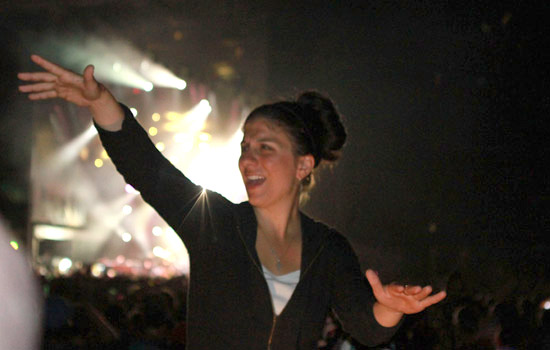NTID grad is ‘Music’s Hottest ASL Interpreter’
Video gone viral of her interpreting for Wu-Tang Clan
Provided
RIT/NTID grad Holly Maniatty found her niche interpreting concerts.
Holly Maniatty had gone to bed Thursday night when her phone started ringing. A video of her working was being shown nationally on Jimmy Kimmel Live.
“I was totally asleep, then all of a sudden I got this rash of phone calls,” Maniatty says.
The video shown was of her working as a sign language interpreter five days earlier at a Wu-Tang Clan hip-hop concert at the Bonnaroo Music and Arts Festival in Tennessee.
The video of her swaying to the beat while signing in a brisk fashion to keep up with the lyrics in front of the stage had gone viral. An entertainment website called her “Music’s Hottest ASL Interpreter.”
Maniatty, 32, is a 2000 graduate of the American Sign Language English interpretation (ASLIE) program at Rochester Institute of Technology’s National Technical Institute for the Deaf. With more than 1,400 graduates since 1969, it remains the oldest and largest sign language interpreting program in the country.
“So far, the feedback I’ve gotten has been mostly positive,” Maniatty says of her recent stardom. She’s granted more than a dozen interviews for entertainment media and National Public Radio.
It’s the second time in less than a year a graduate of the ASLIE program has made national news for doing her job well. In October, Lydia Callis gained attention while interpreting next to New York City Mayor Michael Bloomberg in preparation for Superstorm Sandy. Callis was named and imitated in a Saturday Night Live skit.
Callis has taken advantage of her fame by creating a blog to help educate people about deaf culture and sign language in hopes that interpreters aren’t seen as a novelty, but as a way for hearing and deaf people to exchange information to provide equal access.
“I think part of the reason this clip went viral is because it is fairly unique to see a sign language interpreter in this genre of music,” says Linda Siple, a professor in NTID’s ASLIE program. “It is an exciting time for deaf people in that they now have access to so many aspects of hearing culture.”
Maniatty, a native of Newport, Vt., decided to learn sign language on a whim when she was scouting for a college.
“I had a couple of scholarships for graphic design,” she says. “I was looking at RIT for that, and I noticed they were known for their sign language interpreting program. It was out of the blue and crazy, but I was intrigued and enrolled.” She knew nothing about sign language but was one of 40 students accepted that year.
“Holly was a very motivated and upbeat student,” Siple says. “She was a good student who actively looked for ways to be involved with deaf and hard-of-hearing students. I’m not surprised that Holly has pursued working in the performing arts; this fits her personality and many talents. We’re proud of Holly and all she has accomplished.”
Maniatty was hired by RIT as an interpreter two days after her graduation. She remained working in Rochester as a freelance interpreter and for a local interpreting agency before moving to Portland, Maine, in 2003, where she’s a call center manager for Sorenson Video Relay.
She decided to interpret at music festivals and concerts more than 10 years ago. She tries to learn the lyrics to the songs expected to be played so she can practice without being surprised.
“The first time I did a hip-hop concert, I probably spent 100 hours getting ready for a two-hour show,” she says. “I love hip-hop music, but it’s a challenge for an interpreter.” Hip-hop artists usually speak very quickly and are often intense, which means her level of signing must reflect that intensity. Sometimes, the artist may also go “freestyle,” using unscripted lyrics that can’t be practiced in advance.
She estimates she’s signed at 150 concerts ranging from “little church concerts” to Marilyn Manson, Phish, U2 and Mumford & Sons. She interpreted for the final Beastie Boys concert and was surprised when Bruce Springsteen came off the stage in 2009 to dance with her during a concert in New Orleans.
The concertgoers she interprets for come away feeling they’ve truly experienced the show.
“I love the deaf community. I love ASL. But as a second-language user, I’m never going to be perfect, so it’s a challenge,” she says. “I’ve made a strong commitment because I’m borrowing someone else’s language to make a living. You have to have a lot of respect for the deaf community and Deaf culture. I am privileged to be part of someone’s life every day, whether it’s at a school meeting or someplace very visible, like a concert.”
Her favorite concert to interpret so far was for Billy Joel. “He’s someone I could listen to all my life,” she says. “It was definitely one of the top 10 moments of my life.”
Maniatty credits her training in the ASLIE program to her success. “They are all phenomenal instructors. The stuff they taught me years ago I still go back to every day. They were constantly pushing me to grow. I feel so fortunate to have gone to school there. I go to places and people say, ‘You went to RIT, didn’t you?’ People see that quality.”



